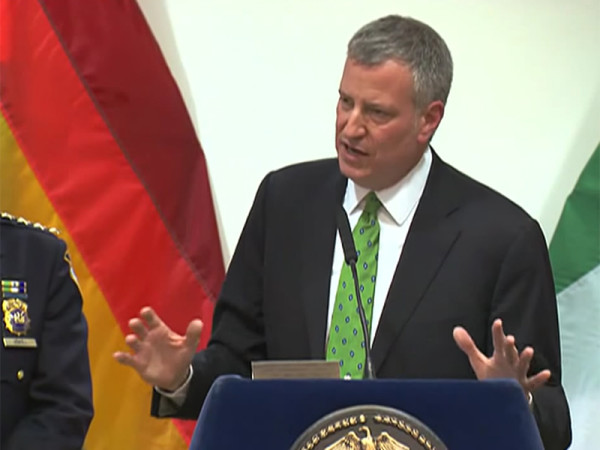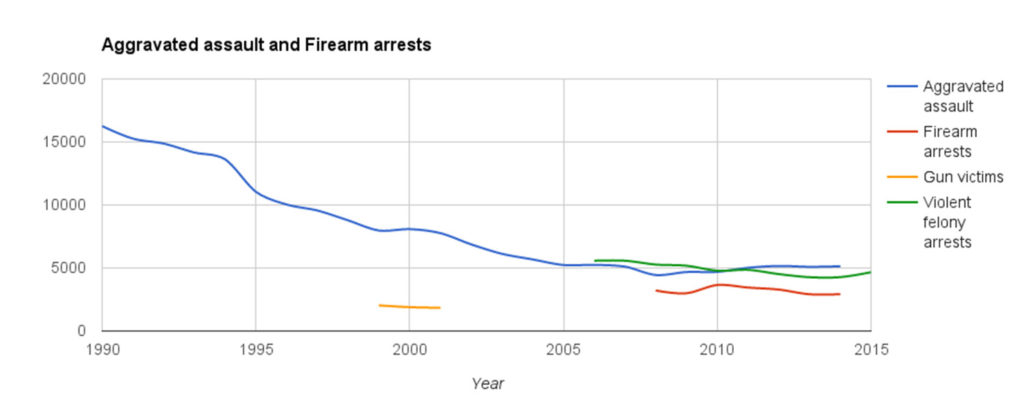Do Fewer Guns Mean More Knives?
The mayor thinks so, but experts beg to differ
Mayor Bill de Blasio speaks at a March 3 conference, where he said that people are turning to a different and ‘less deadly weapon’ because guns have been taken off the streets (NYC Mayor’s Office)
Is one reason for an increase in knife attacks in New York City because guns are getting harder to get? The mayor seems to think that may be true.
Calling it a phenomenon that is “really worthy of examination by the media,” Bill de Blasio made the knife-gun connection at a press conference in March. “There’s been a major increase in gun seizures,” he said. “I’m not a criminologist, but I can safely say that guns are being taken off the street in an unprecedented way. Some people, unfortunately, are turning to a different weapon.”
But the experts are not so sure. Richard Rosenfeld—a leading criminologist and professor at University of Missouri, St. Louis who examined New York City crime trends at the request of NY City Lens—said that he wouldn’t automatically attribute the rise in knifings to anything the city has done with respect to firearms. “It’s possible that people are engaged in weapons substitution, but these events look different than the firearm events to the degree that they involve victims who are more or less randomly selected,” Rosenfeld said. “That’s not typical of homicides, certainly.”
A second expert, Vince Maorino, a lecturer at John Jay College of Criminal Justice as well as the school’s head rifle coach, was less subtle. “I am sorry but I can’t agree that because guns crimes are down, slashing attacks are up,” he said. “Our mayor is one of two things: he either got some bad advice, or he is a blithering idiot.”
He said waves of crime like the recent surge in knife attacks are results of copycat behavior that often dies off. “There was a rash of people being pushed from subway platforms at one point in New York City,” Maorino said. “Nobody said ‘Oh that’s because people can’t get guns.’”
Gun violence went down drastically in New York City in the 1990s and has seen a less steep but still-downward trend over the past two decades. Random slashing attacks in the city, meanwhile, have seen an increase this year, with a 20 percent hike in incidents compared with last year.

However, the definition of the term “random slashing” as city officials defined it in an email this spring meant that a smaller number of attacks were counted as random. But a NY City Lens analysis using a slightly different definition found higher numbers. The Lens analysis of media and police reports on 29 slashing attacks during the month of February 2016 found that in that month alone, 14 of the attacks appeared to be random. The mayor had said earlier that there were “only seven” random attacks for the whole of 2016.
Rosenfeld added that the weapon of choice in these crimes of violence can depend on many things, most notably the person’s age. “Younger suspects are more likely to use a firearm than older suspects,” he said. “It also depends on the circumstance of the crime. Gang-related assaults, for example, are almost always done with a firearm. Drug-related assaults and homicides are nearly always done with a firearm. Domestic incidents less likely to involve a firearm but also not very likely to involve a knife.”
Legality does not play into people’s decisions, the criminologist said. But, he added, the ease of acquiring a knife may make slashing attacks more likely to occur.
A number of slashings have occurred in homeless shelters in the city in 2016, or have involved people who live in shelters. Earlier this year, a group of unarmed guards discovered a collection of knives and blades during a sweep of the city-operated men’s homeless shelter at 30th Street and First Avenue.
Clients at shelters often have easy access to knives through stores and illegal sales among each other, said Derek Jackson, head of law enforcement at Teamsters 237, the union representing unarmed guards at city shelters and other local agencies. However, there could be another reason behind the discovery of these weapons, he said.
“A number of these clients are ex-offenders,” Jackson said. “They come from Riker’s Island and they get released to the men’s shelters or the women’s shelters. Then the shelters assess them to find out where they should be sent—to a mental or chemical abuse shelters, to a sex offender’s shelter, to a women’s shelter, etc.”
Jackson said a large percentage of people who come to homeless shelters are those with mental or chemical abuse issues, and sex offenders, thereby putting officers at risk.
“And their weapon of choice is box cutters and razor blades,” he said.
New York City law bans blades that are four or more inches long. State law, meanwhile, says the possession of a gravity knife, switchblade, ballistic knife, and a host of other knives is illegal. One group claims, however, that the NYPD is not entirely up to speed on the different kinds of knives and the laws dictating their use. A group calling itself the Knife Rights organization has filed a federal civil rights lawsuit challenging the constitutionality of New York legal authorities interpretation of knife laws and the arrest of individuals carrying common folding knives, according to Doug Ritter, founder of the advocacy group.
“If you look at the news reports on the recent slashings in New York, they have nothing to do with the everyday pocket knives that we are concerned with,” he said. “Most of these slashings by deranged individuals are being done with common kitchen knives, which are found in homes throughout the city in the millions.”
The lawsuit is expected to go to trial in June of this year.
The Impact
One Shoe At A Time: A Mother Turns Pain Into Purpose
An Unsolved Shooting Baffles a Mom for Two Decades
How Grief and Anger Turned Into Action
Silver Gun: A Robbery in Queens
Shooter: “It’s Either Them or Me”
After a Single Dad is Shot, a Community Reels
